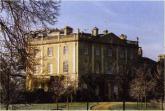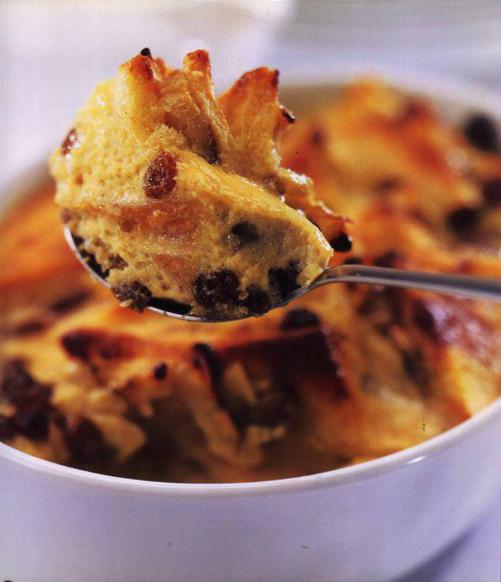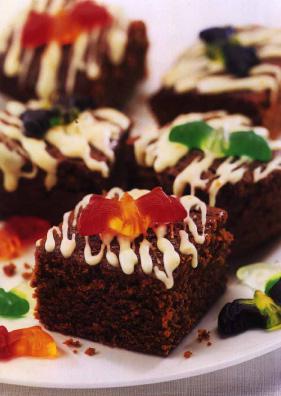In The Royal Manner (22 page)

2.
Split the vanilla pod down the middle and scrape the seeds into a saucepan. Add the pod and pour in the cream. Heat until just about to boil then remove from the heat and stand for 30 minutes.
3.
Meanwhile, spread the bread thickly with remaining butter and then cut in half diagonally. Peel and finely slice the banana and arrange on 6 pieces of bread. Sandwich with remaining bread and cut in half again. Arrange, overlapping, in the prepared dish.
4.
Whisk together the eggs and sugar until pale and frothy, and pour the cream through a sieve over the eggs. Pour over the bread, and sprinkle the remaining sultanas over the top.
5.
Place the gratin dish in a roasting tin and pour sufficient boiling water into the roasting tin to come halfway up the side of the gratin dish. Bake for 30 – 35 minutes until the blade of a small knife inserted into the centre of the pudding comes out clean. Serve hot with pouring cream.
HIGHGROVE HOUSE
The Prince of Wales bought this listed Georgian country house in 1980. Nestling in the foothills of the Cotswolds in Gloucestershire, he intended it to be his country retreat for himself and his then future wife, Lady Diana Spencer. Over the years, the couple took a great interest in the development of Highgrove, and it became an invaluable retreat for them and their family.

The three-storey house acquired a nursery and two guest suites for weekend entertaining. Outside in the grounds, several acres of garden, including a magnificently restored Victorian walled kitchen garden, have been developed into a well-planned and beautiful hideaway for the Prince of Wales and his sons.


STICKY GINGER
AND
ORANGE BAT CAKES
A variation of Parkin, a gingery, treacle cake from the north of England, which will be popular with children of all ages.
Mains: 12
Preparation time: 20 minutes plus cooling and setting
Cooking time: approx. 50 minutes
100g/4oz black treacle/molasses
100g/4oz golden syrup
100g/4oz dark muscavado sugar
100g/4oz butter
225g/8oz self-raising flour
1 tsp ground ginger
1 tsp mixed spice
1 tsp finely grated orange rind
150 ml¼ pt + 4 – 6 tsp freshly squeezed orange juice
100g/4oz icing sugar
12 black bat jelly or gummy sweets
Preheat the oven to 160° C/325° F/Gas 3 Grease and line a 20cm/8in square cake tin.
1.
Place the treacle, syrup, sugar and butter in a saucepan and heat gently until melted together.
2.
Sift the flour and spices into a mixing bowl and make a well in the centre. Add the orange rind and pour in 150 ml/¼ pt orange juice, and then stir in the melted mixture to form a smooth, thick batter.
3.
Pour the mixture into the prepared tin and bake for 50 minutes or until risen and firm to the touch. Leave to cool in the tin on a wire rack. Then turn out and cut into 12 equal portions, and arrange on a wire rack.
4.
Sift the icing sugar into a small bowl and then add sufficient of the remaining orange juice to form a smooth, soft icing. Using a teaspoon, drizzle the icing over each piece of cake, and top each piece with a bat sweet. Stand for 15 minutes to set before serving.
Cook's note:
if you prefer, you can make edible bats for decoration from a small piece of black fondant icing. Roll out the fondant thinly on a surface lightly dusted with icing sugar, and cut out 12 small bat shapes using a cutter or template. Place on the ginger cake before the icing sets.
HALLOWE'EN AND GUY FAWKES NIGHT
In the UK the celebration of Hallowe'en derives from the tradition of Hallowtide, a two-day feast linking the eve of All Saints’ Day (1 November) to All Souls’ Day (2 November). The early Christian church incorporated the great pagan feast of Samhain, which marked the end of the summer and autumnal season and the onset of winter – the time when the dead were believed to return to walk the earth and bring evil with them. Fires were lit lo keep them away, and much drinking, dancing and feasting took place, and sometimes human sacrifices were made.
The Church disapproved of this and the feast of All Souls’ was adapted to remember the dead and to pray for the souls in Purgatory.
Soon human sacrifice gave way to bonfire effigies. One, Shandy Dan, was held at Balmoral, and was enjoyed by Queen Victoria. Games became harmless rituals – bobbing apples for example. Bands of young men visited neighbours and friends wearing masks and odd clothes. Soul-cake, a warm currant cake, was handed out to the men as they passed by.
This ancient ceremony links effortlessly with Guy Fawkes Night. Fawkes, a Catholic, was the active member of a plot to blow up the Houses of Parliament on 5 November 1605. A small band headed by Robert Catesby arranged with Fawkes to plate barrels of gunpowder in a cellar underneath the parliament buildings.
One conspirator, however, sent a letter to a friend saying that ‘parliament would suffer a blow from which it could not recover’. The letter was given to James I, who deduced that gunpowder was intended. He ordered the cellars to be searched and Fawkes was discovered.
Fawkes was tortured, hung, drawn and quartered, but his name lives on with the effigies which are burnt on bonfires at the celebrations held on or near 5 November. To all this has been grafted the American custom of Hallowe'en, which in Britain takes the form of children visiting houses and demanding ‘trick or treat’.

SPOOKY JACKET POTATOES
For an alternative to serve with the soup, bake medium-sized potatoes in their skins and then cut in half. Scoop out the potato flesh into a bowl and mash with a knob of butter and a little milk or cream. Season and then pile back into the potato shells. Smooth the surface of the potatoes and then squeeze the potato halves about one third of the way down so that a slight dent forms in each side. Decorate this end of the potato with small pieces of black olive to look like eyes and a mouth and return to the oven at a low heat to keep warm until ready to serve.


Christmas is the most magical and exciting time of year. The celebration of the birth of Jesus is the time when families come together to exchange gifts, enjoy each other's company and eat, drink and generally be very merry! For me, Christmas conjures up memories of excitement and anticipation. It was instilled in my two younger brothers and me that Father Christmas would only come when we were asleep.
For many years, the Queen traditionally spent the festive season at Windsor Castle, as it could easily accommodate her ever-growing family.
My first-ever duty as a young footman back in 1976 was to serve coffee to the Queen at dinner on Christmas Eve in the State dining room of Windsor Castle. Imagine the scene: the entire Royal Family sitting around a huge polished table and an unfamiliar, very nervous eighteen-year-old boy crosses the room with a tray of rattling coffee cups. I was absolutely terrified, but it was a situation I soon became accustomed to.
After Christmas the Royal Family would move to Sandringham House, the Queen's private home in Norfolk, for the New Year celebrations. However, in recent years, Sandringham has become their home for the entire Christmas and New Year period. The family can be seen attending church on Christmas morning at the small parish church within walking distance of Sandringham House.
Christmas at Kensington Palace was entirely different. It was always the Princess's wish for her boys to experience this special time of the year with their father, grandparents, aunts, uncles and cousins. She chose to spend Christmas alone, although on one memorable occasion it was spent in the company of the entire Kensington and Chelsea Fire Brigade as her scented candles accidentally triggered off the fire alarms!
